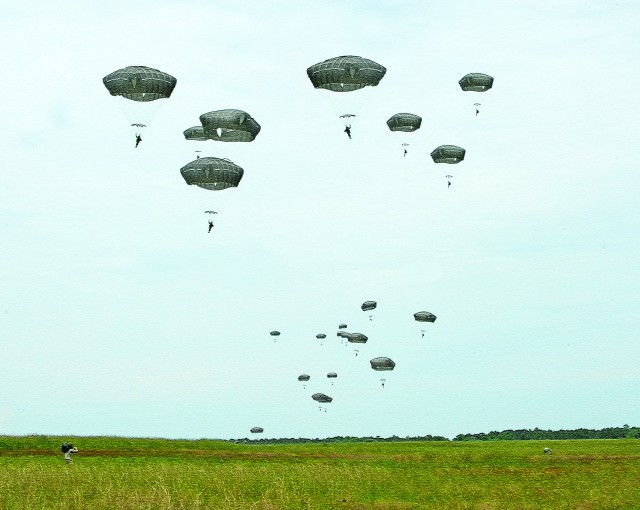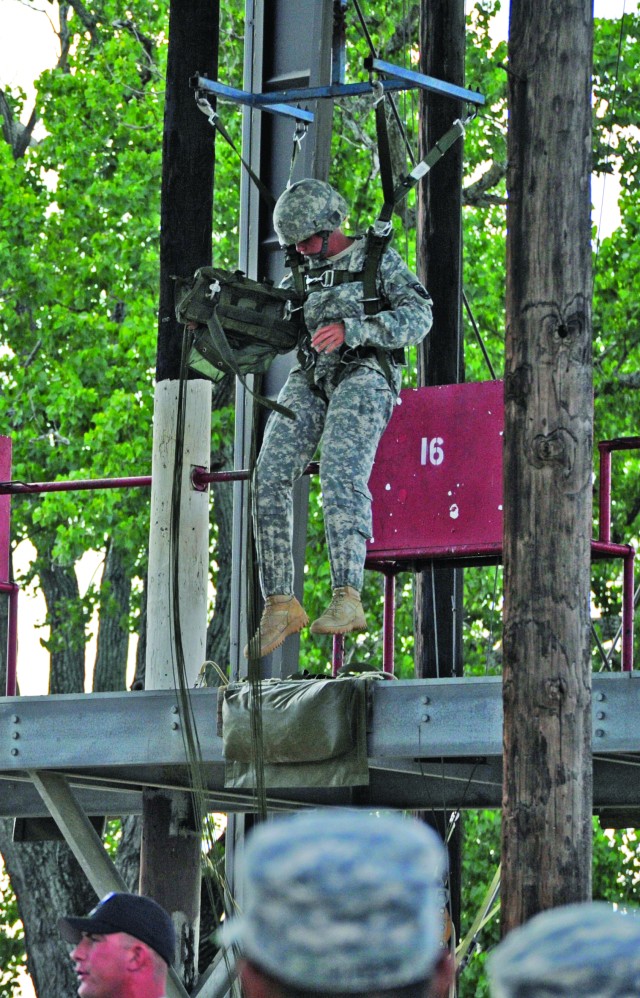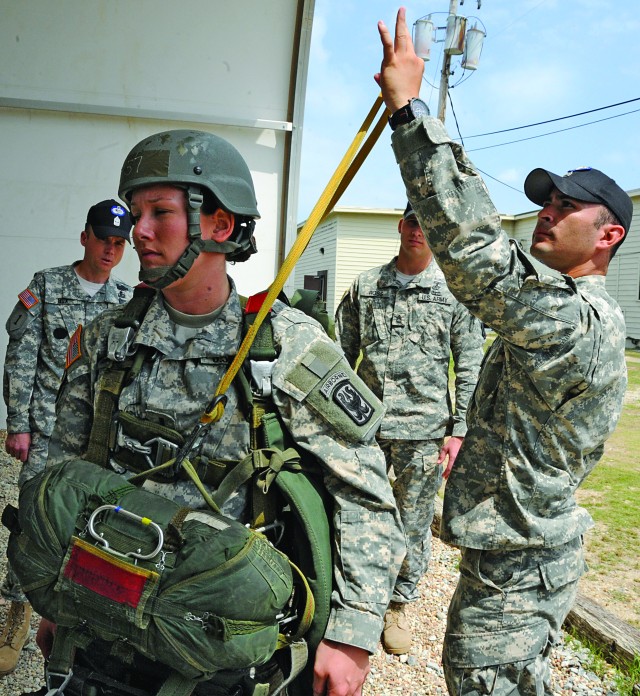"Jumpers ... Hit it! Check canopy!"
Although the written word cannot convey the inflection, pitch or volume of the commands shouted by Sergeants Airborne, these exercises are all too familiar at Fort Benning's Basic Airborne Course in Georgia. Sergeants Airborne, also known as Black Hats, drill these procedures into BAC students until the future paratroopers' reactions are second nature.
Ask any Soldier who has been stationed at Fort Benning. There's something nostalgic, something evocative about those jump towers that define the skyline of the post. The very sight of them has moved many a Soldier to enlist in jump school, while scores of students have used them as motivation to complete timed runs during jump school PT. And just as the towers are a genuine fixture of airborne school, the U.S. Army's Basic Airborne Course is the school that trains every military member who wears the coveted jump wings.
First Sgt. George Box, branch chief for Jumpmaster and Pathfinder Schools, calls BAC the world's mecca for basic airborne training. "When I first came to Fort Benning to the 29th Infantry Regiment, I always saw the towers and students ... I wanted to go airborne. After about a month, I saw the sergeant major of the 507th in the PX and chased him down. I told him I wanted to come to the 507th, and a few phone calls and e-mails later, they got me over here."
Box said that the reason BAC is so special is because it's the starting place for everyone who is airborne: Delta Force; SEALs; Rangers; paratroopers at Fort Bragg, N.C.; all the sister services; and some international forces. "They all start here," he exclaimed with some nostalgia. "The saying is that this [the 507th Parachute Infantry Regiment] is every paratrooper's regiment. Doesn't matter where you go; this is where it all starts."
"Eubanks Field, Fryar Drop Zone, those 250-foot towers ... they define Fort Benning, Ga.," said Command Sgt. Maj. Chip Mezzaline, 1/507th PIR command sergeant major. "Those towers are the first thing people see when they enter post."
Reverence for the airborne lineage is something BAC ingrains into its students. "Just the other day, we were out on Eubanks Field," Mezzaline explained. "There are a lot of memorials out there. I jogged up on a platoon, and Sergeant Airborne stopped the formation so we could discuss some history. That's the kind of thing that's inculcated into those students. You know, the Airborne Walk Memorial itself, which was dedicated in 1986, holds a huge piece of our history from the last 20 years."
The memorials and historical significance of airborne paratroopers goes well beyond the tangible pieces one finds throughout Fort Benning. The bonds and camaraderie shared within the airborne community past and present are best depicted by a deep-running respect and pride for a brotherhood that lasts a lifetime.
The Basic Airborne Course trains around 18,000 people a year, so imagine how many people have gone through the school since it was officially organized in May 1942. Mezzaline said he receives an inordinate number of phone calls from paratroopers past and present with all sorts of requests.
A recent call that stands out was from a retired major, a Vietnam War veteran, who had participated in Operation Junction City, the largest airborne operation in Vietnam since World War II. The major was trying to locate a photo of his airborne class. Mezzaline said that, ironically, two months prior, another gentleman who had been in the same BAC class as well as Operation Junction City had stopped by the battalion.
"I was able to put these two veterans in touch with each other," he explained. "The retired major later told me, 'I would have never been as successful as I am today if it weren't for my Sergeant Airborne. I had doubts about what I was capable of doing, but Sergeant Airborne pulled me aside and straightened me out. I went on to complete airborne school and be successful in life,' the major said. And that's just one of the many stories about the folks who come through here," Mezzaline added.
PERFECTLY SAFE
When it comes to performing their jobs, the instructors at the Basic Airborne Course have no other choice - they must be perfect. Risk assessment is a way of life built into their daily routines, and the magnitude of their responsibilities can sometimes weigh quite heavily.
"On a day-to-day basis, airborne school is pretty dangerous," said Sgt. 1st Class Brian Ross, master trainer for the ground branch at BAC. "The jumpmasters are getting the jumpers out of the bird without any static line injuries; that's a tremendous responsibility for so many Soldiers' safety, and it can really be nerve-racking at times. But, that's the job."
Ross, who is in charge of all training apparatuses and ensuring maintenance is up to date, developed a checklist for the 250-foot tower so his NCOs wouldn't forget any details when conducting inspections. "We must constantly and continuously conduct risk assessment in everything we do," he added.
"Perfection is the standard," said Staff Sgt. Rommel Hurtado, who used to be an instructor at BAC but now teaches at Jumpmaster School. "When you're on the aircraft, you've got all these scared airborne students who are thinking, 'Oh my God, is my parachute going to open' Am I going to be all right after this''"
Hurtado, who is the current reigning Black Hat of the Year, explained that confidence is a key ingredient in the aircraft. "Students need to know everything is going to be just fine. When you're in that door at 1,500 feet or whatever height, you need to make sure you don't miss any detail, so the students can see that this jumpmaster is a professional and will follow his word."
It's the heavy burden of responsibility for jumper safety that deters many NCOs from wanting to be a jumpmaster or airborne instructor. Many responsibilities of a jumpmaster and airborne instructor are the same. In the aircraft, they are exactly the same.
Among the many responsibilities in the aircraft are ensuring all jumpers are properly hooked up to the static line cable, the static line is properly routed over the correct shoulder, good rip cord awareness, safe static line handoff to the safety jumpmaster, eye-to-eye contact, proper door exit and tight body position.
"The last person[s] those jumpers see before going out the door [are] the jumpmaster and the safety, who is also a jumpmaster - both Sergeants Airborne," Mezzaline said. "I can't think of anything better that instills confidence. Those Sergeants Airborne have the weight of the world on their shoulders, and I just can't tell them enough how proud I am of them for all they do."
PINNACLE FOR PARATROOPERS
There are several airborne proficiency levels a paratrooper can achieve: basic, senior and master. Paratroopers can also make themselves more proficient and valuable to the Army by attending Jumpmaster School and Pathfinder School. Yet, one of the true career pinnacles within the airborne community is being a Black Hat - a Sergeant Airborne - at the Basic Airborne Course, teaching young Soldiers how to properly jump out of a "perfectly good aircraft," as the saying goes.
Not everyone is cut out to be a Black Hat, Hurtado explained. Being a jump school instructor requires impeccable memorization skills, as formal and informal blocks of instruction necessitate, again, perfection. An additional challenge is making sure that what you preach is exactly what you do. "There is no room for double standards; never 'do as I say, not as I do.' What you teach must be exactly what's in the manual ... what's right," he said, adding that what you do in the aircraft must be perfect.
Jump school is unique in that for many of its students - about 75 percent - it is the first time they will come in contact with an NCO. Most of the students are cadets and officers: cadets from ROTC, a military academy, Officer Candidate School, new lieutenants, etc. And the majority of the enlisted Soldiers are fresh out of Advanced Individual Training.
"It's really important that the first interaction those young officers and Soldiers get, after their AIT drill sergeants, is with professional NCOs. When they look at that Black Hat, it should be what right looks like in the Army," emphasized Sgt. 1st Class Robert Contratto, chief instructor at BAC.
BAC students are assigned to one instructor for the three-week course. Typically, instructors are assigned 30 to 40 students each class cycle, and on many occasions, instructors speak in front of groups as large as 500. BAC senior enlisted all agree that teaching at jump school is a fantastic opportunity for junior NCOs to develop leadership skills.
"There's no place else in the Army where a sergeant or staff sergeant can expect to supervise 30 personnel," Contratto points out. "A young sergeant who comes here is going to learn a lot of leadership skills, how to deal with officers and how to negotiate that officer-NCO relationship. They'll develop that under our scope of supervision, so when they leave here after a few years and go back to the force with the eight men in the rifle squads, that will be easy," he said.
The Army benefits from those who serve as Black Hats as well. Contratto explained that they focus on airborne operations and teaching the students to be paratroopers, unlike the general force, which has to "isolate all the battle drills and warrior tasks with their Soldiers. When we send that instructor back out to the force, we're giving that new unit a subject-matter expert on airborne operations."
Contratto said he can't praise the instructors enough for all their hard work. "They're out there from 0515 until 1800 at night, trying to get everyone to graduate the course. That's their goal. No one here is trying to protect the badge. We want to see all the students graduate, which is why the instructors are out there training in 100 degrees, the pouring rain, as well as the freezing temps and high winds. They are the unsung heroes of the course here."
BLACK HAT OF THE YEAR
Every October, the 507th PIR holds a competition with a coveted title that all Black Hats chase after - Black Hat of the Year. The winner is considered to be the top performer and standards-setter. The competition is spread out over the course of one month and consists of many events, including giving classes, conducting jumpmaster personnel inspection sequences, oral exams, written exams, physical fitness, practical work within the aircraft, rigging equipment and a mystery event. This year, the mystery event was a mock board conducted by senior master trainers and the command sergeant major.
Hurtado, the current 2010-2011 Black Hat of the Year, said winning the competition was a milestone in his military career. He had participated the year prior but was disappointed in his performance. He said he returned this year with a different attitude, and his experience paid off. His final score was 949 points out of a possible 1,000. He also alluded to the fact that most of the winners are instructors at BAC, which is not surprising. Previous winners include Ross (2008-09) and Box (2007-08), and both maintain the same reverence for the title.
Box, whose reign was cut short by a deployment to support the war on terrorism, said being Black Hat of the Year has been the pinnacle of his career. "Just being at BAC has been the zenith. Being part of this battalion, this unit, I love it. I've been to Italy twice, and being in the 507th is the best assignment I've ever had. I was at Bragg; I was a drill sergeant. Nothing compares," he admitted.
Ross, who is currently on orders to Fort Carson, Colo., described winning the Black Hat of the Year competition as doing your job better than the other guy - on that day. "I don't feel I'm any better than the other Sergeants Airborne out there. But that day, I just happened to be so. Everyone has their good and bad days, so it boils down to the day of the competition."
The mystery event for Ross' year involved climbing the 250-foot tower. The quickest person to scale it and come down would win the event, and Ross nailed it. He said, that year's mystery event also included a written portion, consisting of a 120-question test about the battalion standard operating procedures.
Perhaps even more prestigious than holding the title of Black Hat of the Year is the opportunity to slide into an instructor spot at Jumpmaster School or a master trainer slot at BAC. "When I won the competition, there was a master trainer position open, so the sergeant major said whoever wins gets that slot. That's how I got into this slot. Actually, I had my choice to work here at BAC or Jumpmaster School," Ross explained.
AIRBORNE, SERGEANT AIRBORNE
So, you're a high-speed paratrooper, and now you want to be a Sergeant Airborne' Many people have the wrong impression and think they have to be a jumpmaster in order to be a Sergeant Airborne. Not true, said Contratto. "Just about anybody can come here and be an instructor, any military occupational specialty."
Potential instructors go through a rigorous screening process. Essentially, they are handpicked by the brigade command sergeant major, and then the battalion command sergeants major. After being assigned to a company, the new candidate will go through BAC instructor training. Once the newly minted Sergeant Airborne wears the prestigious black hat, BAC will send him or her to Jumpmaster School. BAC personnel said the overall objective is to send all personnel to Jumpmaster and Pathfinder School.
Mezzaline and Contratto both agree that BAC always has its eyes out for great NCOs who want to work hard and train students. Teaching at the Basic Airborne Course is an excellent professional development opportunity for junior NCOs.
Historically, the school was one of the first in the Army to train officers and enlisted together, Contratto said. "It's also one of the first schools in the Army that's NCO-driven and NCO-run. This course is totally run by NCOs who are responsible for oversight of all training. The commander and company commanders make the training schedules, but it is NCO-driven and executed," he explained, adding that at BAC, first sergeants and platoon sergeants are empowered to execute training.
But Mezzaline warns that coming to BAC doesn't equate to taking a knee. "You'll be at home every night with your family, but the job includes hard work and long days out on the drop zone and in the training areas."
The command sergeant major extended a personal invitation to interested and qualified NCOs who would like to become a Black Hat. But, he added, "This assignment isn't for everyone. Only the best can be a Sergeant Airborne."
Interested in becoming an instructor at BAC' Log on to the infantry Human Resources Command website to find out more information (AKO login required), and contact your branch manager to request the assignment. To contact Linda Crippen, send e-mail to linda.crippen@us.army.mil.








Social Sharing